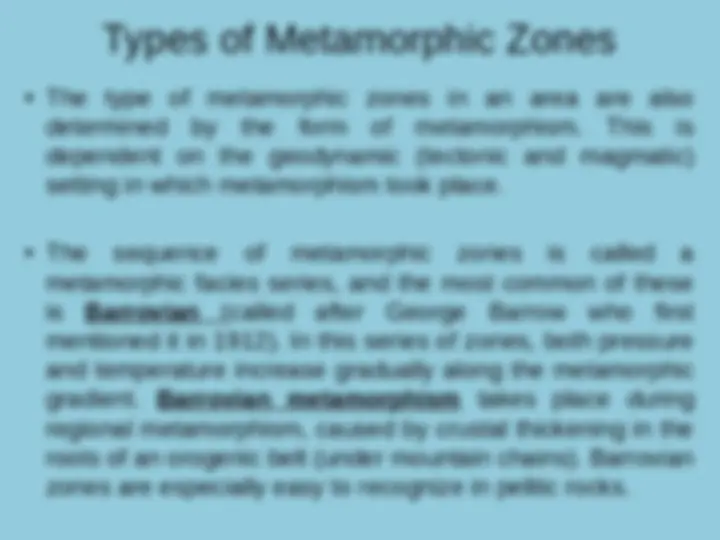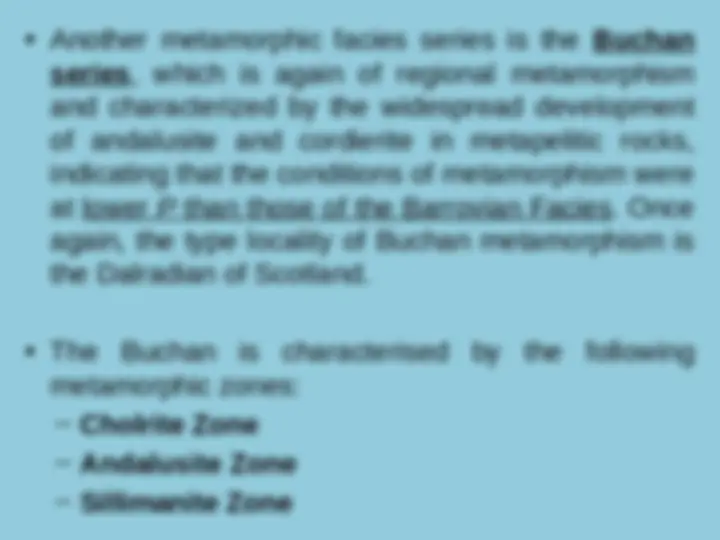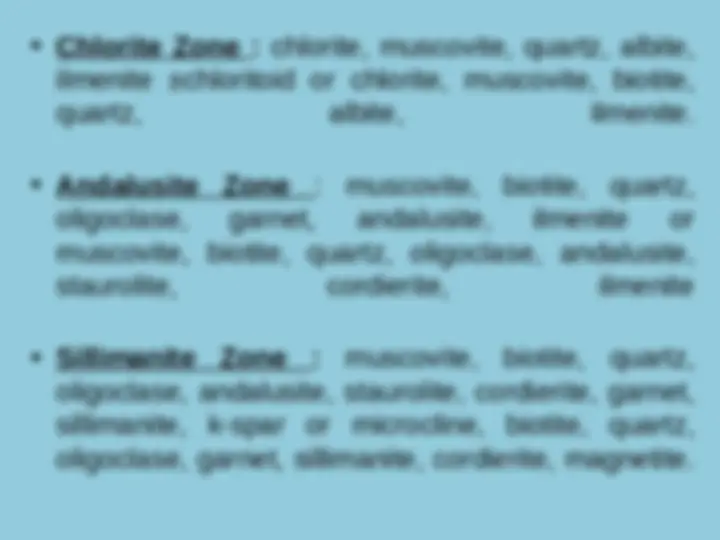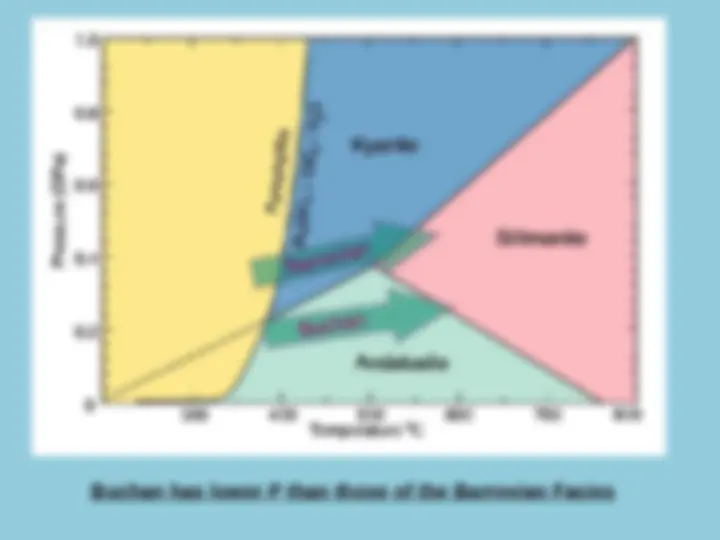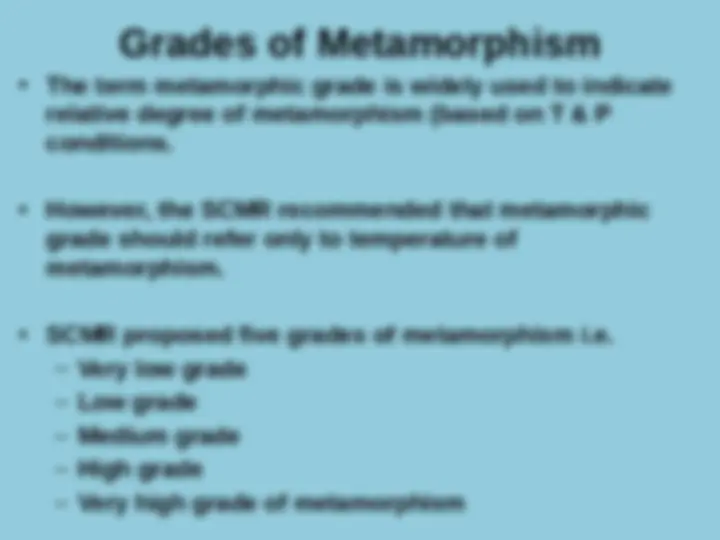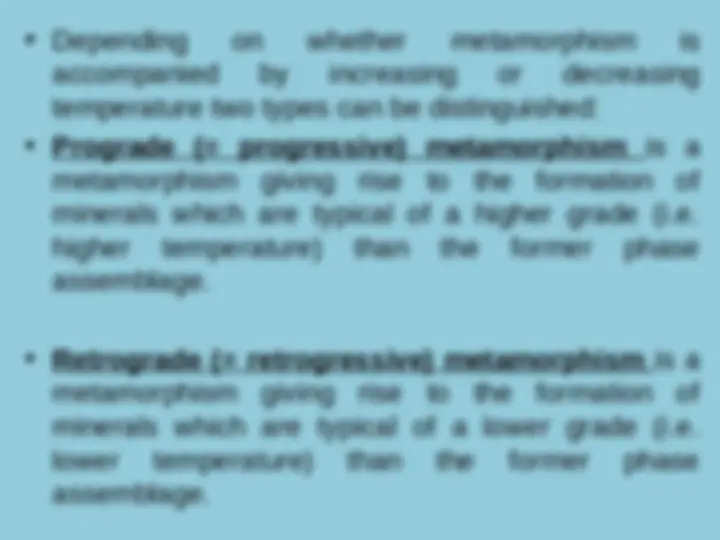Download Metamorphic Zones and Grade and more Study Guides, Projects, Research Geology in PDF only on Docsity!
Metamorphic Zones &
Grades
Metamorphic Zones
- (^) A metamorphic zone is a geographically restricted group of metamorphic rocks defined by a distinctive fabric, mineral assemblage, or index mineral that reflect the metamorphic conditions like temperature, pressure, or the activity of a particular component.
- (^) In other word a metamorphic zone is an area where, as a result of metamorphism, the same combination of minerals occurs in the bed rocks. These zones occur because most metamorphic minerals are only stable in certain intervals of temperature and pressure.
- (^) Barrow (1893) while working in the Dalradian series in the Scottish Highlands, mapped textural and mineralogical changes in pelitic rocks that he related to increases in temperature. Texturally he saw the development of slates to phyllites to mica schists to gneisses. He noticed that these could also be related to mineralogical changes that he called zones: LOW chlorite zone biotite zone garnet zone staurolite zone kyanite zone HIGH sillimanite zone
Chlorite zone. Pelitic rocks are slates or phyllites and typically contain chlorite, muscovite, quartz and albite Biotite zone. Slates give way to phyllites and schists, with biotite, chlorite, muscovite, quartz, and albite Garnet zone. Schists with red almandine garnet, usually with biotite, chlorite, muscovite, quartz, and albite or oligoclase Staurolite zone. Schists with staurolite, biotite, muscovite, quartz, garnet, and plagioclase. Some chlorite may persist Kyanite zone. Schists with kyanite, biotite, muscovite, quartz, plagioclase, and usually garnet and staurolite Sillimanite zone. Schists and gneisses with sillimanite, biotite, muscovite, quartz, plagioclase, garnet, and perhaps staurolite. Some kyanite may also be present.
- (^) Each zone is characterized by the appearance of a new mineral that is easily identified in the field (or in hand specimen) and is hence called an index mineral. After a mineral has formed, it may persist through several higher zones.
- (^) Thus an index mineral is used in geology to determine the degree of metamorphism of a rock. When an index mineral is found in a metamorphosed rock, it indicates the minimum pressure and temperature the protolith (pre-existing rock) must have achieved in order for that mineral to form. For Example in above Barrovian series each zone is named for the index mineral that appears in it. e.g. the chlorite zone is named for chlorite.
- (^) Another metamorphic facies series is the Buchan series , which is again of regional metamorphism and characterized by the widespread development of andalusite and cordierite in metapelitic rocks, indicating that the conditions of metamorphism were at lower P than those of the Barrovian Facies. Once again, the type locality of Buchan metamorphism is the Dalradian of Scotland.
- (^) The Buchan is characterised by the following metamorphic zones: - (^) Cholrite Zone - (^) Andalusite Zone - (^) Sillimanite Zone
Buchan has lower P than those of the Barrovian Facies
Depth Zones of Metamorphism
- (^) Becke (1903) followed by Niggli (1924) proposed three depth zones of metamorphism: - (^) The Upper or Epi-zone - (^) The Middle or Meso-zone - (^) The Lower or Kata-zone
- (^) Upper or Epi Zone : It is the zone of low grade metamorphism where temperature ranges from 100 to 300 degree celcius, pressure is low to moderate. It is characterised by presence of hydrous mineral assembladge like sericite, chlorite, muscovite, biotite, epidote, talc, actinolite etc.
Grades of Metamorphism
- (^) The term metamorphic grade is widely used to indicate relative degree of metamorphism (based on T & P conditions.
- (^) However, the SCMR recommended that metamorphic grade should refer only to temperature of metamorphism.
- (^) SCMR proposed five grades of metamorphism i.e.
- (^) Very low grade
- (^) Low grade
- (^) Medium grade
- (^) High grade
- (^) Very high grade of metamorphism
- (^) Depending on whether metamorphism is accompanied by increasing or decreasing temperature two types can be distinguished:
- (^) Prograde (= progressive) metamorphism is a metamorphism giving rise to the formation of minerals which are typical of a higher grade (i.e. higher temperature) than the former phase assemblage.
- (^) Retrograde (= retrogressive) metamorphism is a metamorphism giving rise to the formation of minerals which are typical of a lower grade (i.e. lower temperature) than the former phase assemblage.
Isograd

